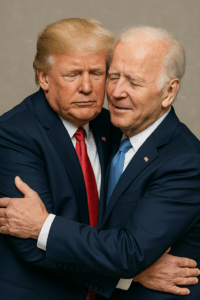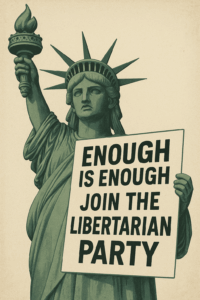Now Is the Time to Join the Libertarian Party
In a time of deep political disillusionment, Americans are increasingly waking up to a hard truth: neither of the major parties is serious about protecting your freedoms, your wallet, or your future. The promises made by Republicans under Donald Trump have too often rung hollow, while Democrats continue to double down on bloated bureaucracy and overreaching government control. If you believe in liberty, limited government, and personal responsibility, then now is the time to act. Now is the time to join the Libertarian Party.
 Broken Promises and Bloated Government
Broken Promises and Bloated Government
Donald Trump campaigned on a platform of shrinking government, restoring liberty, and draining the swamp. Yet the federal deficit has exploded, federal surveillance powers have remained intact, and cronyism has flourished. Executive overreach has expanded under the guise of national emergency declarations, and meaningful reforms to the Patriot Act, civil asset forfeiture, and federal spending have been left by the wayside. For all the rhetoric, the federal government has grown more intrusive and more expensive.
On the other side, the Democratic Party offers no reprieve. Their vision for America is one of ever-expanding federal control—more regulations, more taxes, more programs, and less freedom. Whether it’s through sweeping surveillance programs, unending wars, or inflation-inducing spending sprees, their solutions always amount to more government in your life and less control in your hands.
The Libertarian Alternative
The Libertarian Party offers a clear alternative. We believe in your right to live your life free from government interference. We believe that your body, your property, and your choices belong to you—not to politicians, bureaucrats, or party bosses.
But belief alone isn’t enough. To take on the entrenched power of the duopoly, we need to grow. That means increasing our membership, raising funds, and building a national infrastructure capable of running competitive campaigns from city council to Congress. Every new member strengthens our voice and expands our ability to fight for liberty at every level.
Why Now?
We are standing at a critical juncture. As the two old parties continue to consolidate power and trample individual rights, the appetite for a real alternative has never been greater. Americans are hungry for something new—something principled, consistent, and accountable.
But without your support, that hunger will go unanswered.
If you’re tired of broken promises, if you’re fed up with big government from both the left and the right, and if you’re ready to make a real impact, then it’s time to stand with the Libertarian Party.
Join Us Today
Your voice matters. Your vote matters. But your membership matters even more.
By joining the Libertarian Party today, you send a powerful message: You will not be ignored. You will not be silenced. And you will not wait for liberty to be handed to you by the very parties that keep taking it away.
Join now and be a part of building a freer future:
Liberty won’t defend itself. Let’s do it together.
Now Is the Time to Join the Libertarian Party Read Post »



